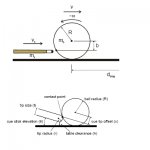using your own drawings: you post exactly the same as me, but you conclude the opposit.
if contact point would be same on both drawings, offset b would me smaller then offset x.
hope its clear now.

The only thing that cue elevation does that visibly helps, is increasing the amount of spin due to a bigger offset. But you can get the same offset with a horizontal cue if the contact point is lower, with same % chance of miscuing.
The only thing that is needed to powerdraw, is the right balance between speed and amount of spin, and as it has been shown, this is more complex then just MAX POWER, MAX OFFSET.
You should need to write a new article in the same line as
TP B.2 - Rolling resistance, spin resistance, and "ball turn"
but with contact resistance, spin resistance,
and aplaying your article about
http://billiards.colostate.edu/technical_proofs/new/TP_A-12.pdf
where you talk about linear impulse, wich automatically imply's, that the linear momentum is dependant on direction of the linear impulse aka the cue elevation,
and aply both things to the equation of powerdraw to incorporate them into the equation of wich speed gives the best powerdraw results.
You havent discussed the two points mentioned, but it explains why MAX speed itsnt correct for all shots :
Imagine you stroke the cb with draw with a strong stroke. The spin will "almost" be constant untill it hits the object ball. The friction this collision induces is in function of the speed at wich it hits the Object ball. (compare it to a spinning polisher, if you press your hand very heavily, it will spin slower, if you just lay down your fingers on it, it wont slow down).
So if you MAX power stroke with a draw shot the cb, the heavy contact between cb and OB will make the cb lose its spin alot more, then if the cb would hit the OB very softly. The collision induced friction of the OB wont slow the draw as much.
on the other hand tOO slow, and the roling induced friction of the cloth will reduced the draw more then the contact will.
You just need to judge witch friction will reduce the spinning cueball the most.
A The cloth friction or
B the collision induced friction.
use the speed that will give you the least losses, and maximise the offset to 80%
another i wanted to talk about that hasn't been used to do the math is this.
The more cue elevation you use, the higher the ball will jump, when it lands on the table (ideally at moment of impact with ob) the cb will bounce several times more then of the ball highest place would be lower with a lower cue elevation.
The cb can only draw back once it has "permanent" contact with the cloth. Without cloth it can't draw. so the longer it rebounds at the place of impact with the ob, the more time draw you will lose. Its is very visible in this video of yours dave :
http://billiards.colostate.edu/high_speed_videos/new/HSVB-24.htm . Watch the cb , its takes 0.5seconds after impact before it starts drawing back. That ALOT of time. That why i advocate a very slight cue elevation, just enough so that at the ideal speed for max draw, the cb bounces all the way to the OB without going to high in the air, and rebounding to often.
edit: with a closed bridge and max tipofset, the angle and rebound are to hight, for the cb the get permanent contact with the cloth to be able to draw back after impact. I can draw the cb 30% further with a flat bridge then with a closed bridge, with same offset and same speed. I use a closed bridge 98% of the time. 2% are for powerdraws.
